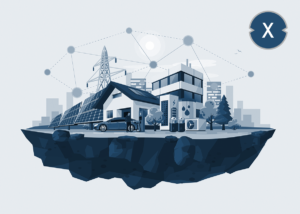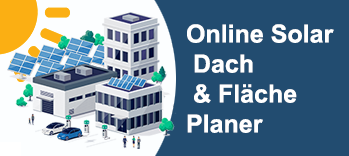Info: Federal Government
Renewable energy
Renewable energy is useful energy produced from renewable resources that renew naturally within a human timeframe, including carbon-neutral sources such as sunlight, wind, rain, tides, waves and geothermal energy. This type of energy source is in contrast to fossil fuels, which are used up much faster than they grow back. Although most renewable energies are sustainable energy, there are also some that are not sustainable, for example biomass.

The website you are looking for is not displayed? We're sorry. We are currently revising the content.
Renewable energy often provides energy in four key areas: power generation, air and water heating/cooling, transportation, and rural (off-grid) energy services.
According to REN21's 2017 report, renewable energy contributed 19.3% of global human energy consumption and 24.5% of its electricity production in 2015 and 2016. This energy consumption is divided into 8.9% from traditional biomass, 4.2% as thermal energy (modern biomass, geothermal and solar heat), 3.9% from hydropower and the remaining 2.2% as electricity from wind, sun, geothermal energy and other forms of biomass. In 2017, global investment in renewable energy reached $279.8 billion, with China accounting for 45% of global investment and the United States and Europe each accounting for around 15%. There were an estimated 10.5 million renewable energy jobs worldwide, with photovoltaics being the largest renewable energy employer. Renewable energy systems are becoming increasingly efficient and cheaper, and their share of total energy consumption is increasing. As of 2019, more than two-thirds of the world's newly installed electricity capacity was renewable. Growth in coal and oil consumption could end by 2020 due to increasing use of renewable energy and natural gas. As of 2020, photovoltaics and onshore wind power are the cheapest forms of building new power generation plants in most countries.
At the national level, renewable energies already contribute more than 20 percent of the energy supply in at least 30 countries around the world. National renewable energy markets are forecast to continue to grow strongly in the coming decade and beyond. At least two countries, Iceland and Norway, already generate all of their electricity from renewable energy, and many other countries have set goals of using 100% renewable energy in the future. In at least 47 countries around the world, more than 50% of electricity already comes from renewable resources. Renewable energy resources are distributed over wide geographical areas, unlike fossil fuels, which are only found in a limited number of countries. The rapid deployment of renewable energy and energy efficiency technologies leads to significant energy security, climate protection and economic benefits. International opinion polls show strong support for promoting renewable energy sources such as solar and wind energy.
While many renewable energy projects are large-scale, renewable technologies are also suitable for rural and remote areas and developing countries, where energy is often critical to human development. Since most renewable energy technologies provide electricity, the deployment of renewable energy is often used in conjunction with further electrification, which has several advantages: electricity can be converted into heat, can be converted into mechanical energy with high efficiency, and is at the location of Consumption clean.
In 2017, investments in renewable energies worldwide amounted to $ 279.8 billion, with $ 126.6 billion in China or $ 45 % of global investments. According to the researcher Dr. Cornelia Tremann ”is now the world's largest investor, producer and consumer of renewable energies and produces state -of -the -art solar panels, wind turbines and hydropower plants” and is also the world's largest producer of electric cars and buses.
solar power
Solar energy, the light and heat radiation emitted by the sun, is harnessed using a number of constantly evolving technologies, such as: B. Solar thermal, photovoltaics, concentrated solar energy (CSP), concentrator photovoltaics (CPV), solar architecture and artificial photosynthesis. Solar technologies are commonly referred to as passive or active solar technologies, depending on the way they capture, convert and distribute solar energy. Passive solar techniques include orienting a building toward the sun, selecting materials with favorable thermal mass or light-diffusing properties, and designing spaces with natural air circulation. Active solar technologies include solar thermal, which uses solar panels for heating, and solar energy, which converts sunlight into electricity either directly through photovoltaics (PV) or indirectly through concentrated solar energy (CSP).
A photovoltaic system converts light into direct electrical current by using the photoelectric effect. Photovoltaics has become a fast-growing multi-billion dollar industry that continues to improve its cost efficiency and, together with CSP, has the greatest potential among renewable technologies. Concentrated solar energy systems (CSP) use lenses or mirrors and tracking systems to concentrate a large area of sunlight into a small beam. Commercial concentrated solar power plants were first developed in the 1980s. CSP-Stirling has by far the highest efficiency of all solar energy technologies.
In 2011, the International Energy Agency said that “the development of affordable, inexhaustible and clean solar energy technologies would bring enormous advantages in the long term. It will increase the energy security of the countries by dependent on a locals, inexhaustible and largely import -independent resource, improve sustainability, reduce pollution, reduce the containment of climate change and keep prices for fossil fuels lower than usual. These advantages are global. Therefore, the additional costs that arise from the incentives for an early introduction should be regarded as learning investments; They have to be used wisely and distributed on a wide base ”. Australia has the largest proportion of solar power in the world; In 2020, the solar energy covered 9.9 % of the electricity requirement.
REN21
REN21 (Renewable Energy Policy Network for the 21st Century) is a think tank and multi-stakeholder governance group focused on renewable energy policy.
REN21 aims to promote policy development, knowledge exchange and joint action for a rapid global transition to renewable energy. REN21 brings together governments, non-governmental organizations, research and academic institutions, international organizations and industry to learn from each other and advance the adoption of renewable energy.
To support policy-making, REN21 provides information, stimulates discussion and debate and supports the development of thematic networks. REN21 facilitates the collection of information on renewable energy. This is done through six products: the Global Renewable Energy Status Report (GSR), Regional Status Reports, Global Future Reports (GFR), Thematic Reports, the REN21 Renewables Academy and the International Renewable Energy Conference (IREC) series.
The REN21 Secretariat is based at UN Environment in Paris, France, and is a registered non-profit association under German law (eV). The organization has more than 65 member organizations (as of 2019).
REN21 was founded in June 2004 as a result of the International Conference on Renewable Energy in Bonn, Germany. Paul Hugo Suding was the first Executive Secretary when REN21 was founded in 2006. He was followed by Virginia Sonntag O'Brien (2008-2011), Christine Lins (2011-2018) and Rana Adib (2018-present).
















